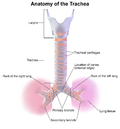Carina of trachea
Carina of trachea is a crucial anatomical structure located within the respiratory system. It is the point at which the trachea, or windpipe, divides into the two primary bronchi that lead to the lungs.
Anatomy[edit]
The carina of trachea is a ridge of cartilage that runs anteroposteriorly between the two bronchial openings. It is located approximately at the level of the fifth thoracic vertebra, although this can vary slightly depending on individual anatomy and body position. The carina is lined with mucous membrane and contains numerous sensory nerve endings, making it highly sensitive to touch and foreign objects.
Clinical significance[edit]
Due to its sensitivity, the carina of trachea plays a crucial role in the cough reflex. When foreign objects or excessive mucus stimulate the carina, it triggers a cough to expel the irritant from the respiratory tract.
In medical procedures such as bronchoscopy and tracheal intubation, care must be taken to avoid stimulating the carina to prevent coughing or other reflex actions. The carina can also serve as a landmark for these procedures, indicating the point of bifurcation of the trachea.
Pathologically, the carina can be affected by conditions such as tracheal deviation and lung cancer. In lung cancer, a tumor may cause the trachea to deviate from its normal position, which can be detected by observing the position of the carina.
See also[edit]
-
Carina of trachea
-
Carina of trachea
-
Carina of trachea
-
Carina of trachea
Ad. Transform your life with W8MD's Budget GLP-1 injections from $75


W8MD offers a medical weight loss program to lose weight in Philadelphia. Our physician-supervised medical weight loss provides:
- Weight loss injections in NYC (generic and brand names):
- Zepbound / Mounjaro, Wegovy / Ozempic, Saxenda
- Most insurances accepted or discounted self-pay rates. We will obtain insurance prior authorizations if needed.
- Generic GLP1 weight loss injections from $75 for the starting dose.
- Also offer prescription weight loss medications including Phentermine, Qsymia, Diethylpropion, Contrave etc.
NYC weight loss doctor appointmentsNYC weight loss doctor appointments
Start your NYC weight loss journey today at our NYC medical weight loss and Philadelphia medical weight loss clinics.
- Call 718-946-5500 to lose weight in NYC or for medical weight loss in Philadelphia 215-676-2334.
- Tags:NYC medical weight loss, Philadelphia lose weight Zepbound NYC, Budget GLP1 weight loss injections, Wegovy Philadelphia, Wegovy NYC, Philadelphia medical weight loss, Brookly weight loss and Wegovy NYC
|
WikiMD's Wellness Encyclopedia |
| Let Food Be Thy Medicine Medicine Thy Food - Hippocrates |
Medical Disclaimer: WikiMD is not a substitute for professional medical advice. The information on WikiMD is provided as an information resource only, may be incorrect, outdated or misleading, and is not to be used or relied on for any diagnostic or treatment purposes. Please consult your health care provider before making any healthcare decisions or for guidance about a specific medical condition. WikiMD expressly disclaims responsibility, and shall have no liability, for any damages, loss, injury, or liability whatsoever suffered as a result of your reliance on the information contained in this site. By visiting this site you agree to the foregoing terms and conditions, which may from time to time be changed or supplemented by WikiMD. If you do not agree to the foregoing terms and conditions, you should not enter or use this site. See full disclaimer.
Credits:Most images are courtesy of Wikimedia commons, and templates, categories Wikipedia, licensed under CC BY SA or similar.
Translate this page: - East Asian
中文,
日本,
한국어,
South Asian
हिन्दी,
தமிழ்,
తెలుగు,
Urdu,
ಕನ್ನಡ,
Southeast Asian
Indonesian,
Vietnamese,
Thai,
မြန်မာဘာသာ,
বাংলা
European
español,
Deutsch,
français,
Greek,
português do Brasil,
polski,
română,
русский,
Nederlands,
norsk,
svenska,
suomi,
Italian
Middle Eastern & African
عربى,
Turkish,
Persian,
Hebrew,
Afrikaans,
isiZulu,
Kiswahili,
Other
Bulgarian,
Hungarian,
Czech,
Swedish,
മലയാളം,
मराठी,
ਪੰਜਾਬੀ,
ગુજરાતી,
Portuguese,
Ukrainian





